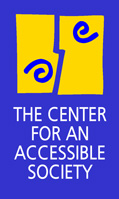
DISABILITY
ISSUES
INFORMATION
FOR
JOURNALISTS
ABOUT
THE CENTER
Universal design resources
Note to readers: links to news articles may not work after a few weeks, as news media remove current stories to their archives. The link may take you to the archives section, where, for a fee, you can view the article.
Feb. 3, 2004 -- The announcement that Elaine Ostroff has been awarded the prestigious Misha Black medal for design education prompts today's e-letter looking at universal design resources.
Ostroff, who co-founded Adaptive Environments in the 1970s, has always been a pioneer in the field of universal design; her particular passion has been in educating design professionals about the concept. She continues her involvement in design education today as director of the Global Universal Design Educator's Network. That incudes her bi-monthly Global Universal Design Educator's Online News (to subscribe to this free e-letter, email her at elaine@ostroff.org) Another universal design e-letter -- this one from the Rehabilitation Engineering Research Center on Universal Design at the University of Buffalo -- is available monthly.
There's also a Global Universal Design Educator's Network e-mail list, hosted by the Trace Research and Development Center -- an interactive e-mail exchange with other people who are interested in teaching and learning about universal design education. Learn more about this e-list.
Universal design is a broad area including design of the "built environment," product design and web design -- all design, in other words, that affects our daily lives. There are increasing signs that companies are starting to pay attention to the concepts, particularly as the Baby Boom ages. Books on using universal design features in homes include Charles Schwab's "Universal designed Smart Homes for the 21st Century: 72 Home Plans you can order and build" following universal design features (for more information visit http://www.universaldesignonline.com ).
Microsoft recently released a study on the "aging workforce," noting that "more than half of computer-using adults in the United States (up to 57%) of ages 18-64 have some sort of impairment, ranging from minor hearing or vision loss to severe hand or wrist pain, from carpal tunnel syndrome, for example, that could make them candidates for the use of accessible technology." Microsoft is now touting the need for better designed computer workstations and accessible programs and websites (for more on this, go to http://www.microsoft.com/enable/research ) If you're interested specifically in keeping up with coverage of tech for blind users, you might want to check out the American Foundation for the Blind's Access World webzine.
Despite the promising signs, the adoption of universal design is not yet universal. "For the millions of Americans who have sight problems, the DVD revolution isn't amounting to much more than a hill of beans," writes Aaron Barnhart, television critic at the Kansas City Star, on his website TV Barn. "You're probably aware that most home video these days is closed captioned. What you don't know is that the same movie studios also pay for a process called audio description (sometimes it's called video description), in which a narrator describes some of the visual action during breaks in the dialogue. It's unobtrusive and cheap," he says, but "when those same movies come out on DVD, the captions are included, but what about the descriptions? They're nowhere to be seen -- or heard. The number of DVDs with audio descriptions is so pitifully few that Joe Clark, a Canadian expert on video accessibility, can maintain the entire list on his personal Web site." Read Clark's list at http://www.joeclark.org/access/dvd/ -- and read Barnhart's column at TVBarn.